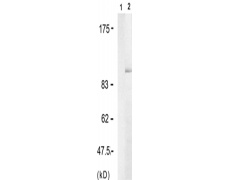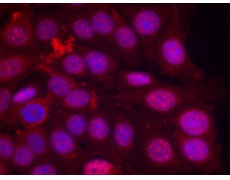中文名稱: 兔抗PGR (Phospho-Ser190)多克隆抗體
英文名稱: Anti-PGR (Phospho-Ser190) rabbit polyclonal antibody
別 名: NR3C3; PGR; PRGR
相關(guān)類別: 一抗
儲(chǔ) 存: 冷凍(-20℃) 避光
宿 主: Rabbit
抗 原: PGR (Phospho-Ser190)
反應(yīng)種屬: Human, Mouse, Rat
標(biāo) 記 物: Unconjugate
克隆類型: rabbit polyclonal
技術(shù)規(guī)格
|
Background: |
Progesterone receptors (PRs) are nuclear hormone receptors of the NR3C class, which also includes mineralocorticoid,glucocorticoid and androgen receptors. They exist as homodimers coupled to Hsp90 or HMGB proteins, which are shed upon activation. The major signaling pathway used by progesterone receptors is via direct DNA binding and transcriptional regulation of target genes. They can also signal by binding to other proteins, mainly with transcription factors such as NF-kappaB, AP-1 or STAT. Progesterone receptors are found in the female reproductive tract, mammary glands, brain and pituitary gland and receptor expression is induced by estrogen. Well established functions of progesterone receptors include ovulation, implantation, mammary gland development and maintenance of pregnancy. In addition,progesterone, signaling through the progesterone receptor, increases the ventilatory response of the respiratory centers to carbon dioxide and decreases arterial and alveolar PCO2 in the luteal phase of the menstrual cycle and during pregnancy. The human gene encoding the progesterone receptor has been localized to 11q22. |
|
Applications: |
WB, IHC, IF |
|
Name of antibody: |
PGR (Phospho-Ser190) |
|
Immunogen: |
Synthetic peptide of human PGR (Phospho-Ser190) |
|
Full name: |
progesterone receptor (Phospho-Ser190) |
|
Synonyms: |
NR3C3; PGR; PRGR |
|
SwissProt: |
P06401 |
|
IHC positive control: |
Human breast carcinoma |
|
IHC Recommend dilution: |
50-100 |
|
WB Predicted band size: |
99 kDa |
|
WB Positive control: |
SKOV3 cells treated with EGF |
|
WB Recommended dilution: |
500-1000 |
|
IF Positive control: |
MCF cells |
|
IF Recommended dilution |
100-200 |



 購物車
購物車 幫助
幫助
 021-54845833/15800441009
021-54845833/15800441009


